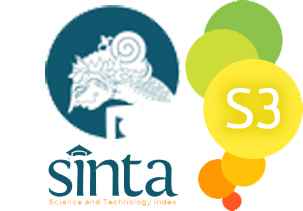The Analysis of Vitamin D Receptor Protein on Salmonella typhi infection in acute recurrent cases in endemic area in Eastern Indonesia
Abstract
The host susceptibility mechanisms such as Vitamin D Receptor (VDR) is involved in the modulation of macrophage function and may possibly correlate with immunity disease including the severity of typhoid fever symptoms. The study aimed to assess the VDR Protein expression in the serums of recurrent acute typhoid fever (RATF) patients and compares it with typhoid fever (TF) patients, and healthy persons (HP). The study employed 30 RATF patients and 30 TF patients selected from primary health centres and hospitals in Eastern Indonesia as the endemic area. All the samples were obtained from several health centers in South Sulawesi, Southeast Sulawesi, Central Sulawesi, East Kalimantan and Papua and then collected in the sample bank Biology Laboratory of Molecular Immunology, Faculty of Medicine, Hasanuddin University. As a comparison, 30 samples of healthy persons were also selected from the Blood Transfusion Unit in Makassar, South Sulwesi Indonesia. The profile of VDR Protein was analyzed with Enzyme-linked Immunosorbent Assay (ELISA). VDR protein content data on RATF and TF were designed according to completely randomized design T test. Subsequently, it correlated to Pearson correlation to determine the interaction between Widal titre and VDR protein levels. A comparison between Widal titre and VDR Protein level was also made to identify the correlation. It was found that the mean of VDR protein expression of RATF was 13,44 ng/mL, the mean of VDR protein expression of TF was 24,88 ng/mL, and the mean of VDR protein expression of HP was 43,49 ng/mL. The correlation results between RATF-TF Widal titre and VDR protein level indicated a negative correlation with p-value of 0,004. There were significant differences in the VDR expression in the RATF, TF, and HP. RATF VDR expression lower than TF and HP and there was also a correlation between Widal titre with VDR Protein expression.
References
Buckle, G. C., Walker, C. L. F., and Black, R. E. (2012). Typhoid fever and paratyphoid fever: Systematic review to estimate global morbidity and mortality for 2010. Journal of Global Health, 2(1), 1–9. https://doi.org/10.7189/jogh.02.010401
Chun, R. F., Liu, P. T., Modlin, R. L., Adams, J. S., and Hewison, M. (2014). Impact of vitamin D on immune function: Lessons learned from genome-wide analysis. Frontiers in Physiology, 5 APR(April), 1–16. https://doi.org/10.3389/fphys.2014.00151
Çiçek, H., Güleken, N., Öztuzcu, S., and Sevinç, A. (2017). Vitamin D receptor polymorphisms and related biochemical parameters in various cancer species. Turkish Journal of Biochemistry, 42(2), 161–168. https://doi.org/10.1515/tjb-2016-0215
Cohen, J. (2018). ‘Frightening’ typhoid fever outbreak spreads in Pakistan. Science, 361(6399), 214. https://doi.org/10.1126/science.361.6399.214
Di Domenico, E. G., Cavallo, I., Pontone, M., Toma, L., and Ensoli, F. (2017). Biofilm producing Salmonella typhi: Chronic colonization and development of gallbladder cancer. International Journal of Molecular Sciences, 18(9). https://doi.org/10.3390/ijms18091887
Dougan, G., and Baker, S. (2014). Salmonella enterica serovar typhi and the pathogenesis of typhoid fever. Annual Review of Microbiology, 68, 317–336. https://doi.org/10.1146/annurev-micro-091313-103739
Dwiyanti, R., Hatta, M., Natzir, R., Pratiwi, S., Sabir, M., Yasir, Y., Noviyanthi, R. A., Junita, A. R., Tandirogang, N., Amir, M., Fias, M., Saning, J., and Bahar, B. (2017). Association of typhoid fever severity with polymorphisms NOD2, VDR and NRAMP1 Genes in endemic area, Indonesia. Journal of Medical Sciences (Faisalabad), 17(3), 133–139. https://doi.org/10.3923/jms.2017.133.139
Dwiyanti, R., Yasir, Y., Sabir, M., Natzir, R., Rahardjo, S. P., Purnamasari, N. I., Saning, J., and Hatta, M. (2015). Titer IgG anti-flagellum Antibody and Flagellin Gene Variants of Salmonella enterica Serovar Typhi as Risk Factor for Typhoid Fever Carriers. American Journal of Infectious Diseases and Microbiology, 3(2), 65–69. https://doi.org/10.12691/ajidm-3-2-1
Efendi, S., Budu, Hatta, M., Natsir, R. I., Sriyanah, N., Maryunis, and Dwiyanti, R. (2019). Analysis of VDR gene expression and its relationship with bacterial load in typhoid fever patients. Indian Journal of Public Health Research and Development, 10(10), 1476–1481. https://doi.org/10.5958/0976-5506.2019.03045.6
Esmailnia, E., Amani, J., and Gargari, S. L. M. (2020). Identification of novel vaccine candidate against Salmonella enterica serovar Typhi by reverse vaccinology method and evaluation of its immunization. Genomics, 112(5), 3374–3381. https://doi.org/10.1016/j.ygeno.2020.06.022
Febriza, A., Natzir, R., Hatta, M., As’ad, S., Budu, ., Kaelan, C., Kasim, V. N., and Idrus, H. H. (2020). The Role of IL-6, TNF-α, and VDR in Inhibiting the Growth of Salmonella Typhi: in vivo Study. The Open Microbiology Journal, 14(1), 65–71. https://doi.org/10.2174/1874285802014010065
Flayhart, D., Borek, A. P., Wakefield, T., Dick, J., and Carroll, K. C. (2007). Comparison of BACTEC PLUS blood culture media to BacT/Alert FA blood culture media for detection of bacterial pathogens in samples containing therapeutic levels of antibiotics. Journal of Clinical Microbiology, 45(3), 816–821. https://doi.org/10.1128/JCM.02064-06
Gillespie, S. H. (2014). Medical microbiology illustrated. Butterworth-Heinemann.
Glocke, M., Lang, F., Schaeffeler, E., Lang, T., Schwab, M., and Lang, U. E. (2013). Impact of vitamin D receptor VDR rs2228570 polymorphism in oldest old. Kidney and Blood Pressure Research, 13, 311–322. https://doi.org/10.1159/000350159
Hamer, D. H. (2010). Public health and infectious diseases. Elsevier.
Hanif, S., Bai, S., Ur Rehman, E., Memon, M. H., Ashfaq, M., and Rajesh. (2021). Emerging trends of resistance of typhoid fever in paediatric population: A hospital based study. Journal of the Liaquat University of Medical and Health Sciences, 20(1), 21–25. https://doi.org/10.22442/jlumhs.2021.00764
Hatta, M. (2011). New flagellin gene for Salmonella enterica serovar typhi from the East Indonesian archipelago. American Journal of Tropical Medicine and Hygiene, 84(3), 429–434. https://doi.org/10.4269/ajtmh.2011.10-0605
Hatta, M., Bakker, M., Beers, S. van, Abdoel, T. H., and Smits, H. L. (2009). Risk factors for clinical typhoid fever in villages in rural South-Sulawesi, Indonesia. International Journal of Tropical Medicine, 4(3), 91–99.
Hatta, M., Pastoor, R., Scheelbeek, P. F. D., Sultan, A. R., Dwiyanti, R., Labeda, I., and Smits, H. L. (2011). Multi-locus variable-number tandem repeat profiling of Salmonella enterica serovar Typhi isolates from blood cultures and gallbladder specimens from Makassar, South-Sulawesi, Indonesia. PLoS ONE, 6(9). https://doi.org/10.1371/journal.pone.0024983
Hatta, M., and Ratnawati. (2008). Enteric fever in endemic areas of Indonesia: An increasing problem of resistance. Journal of Infection in Developing Countries, 2(4), 279–282. https://doi.org/10.3855/jidc.222
Hatta, M., and Smits, H. L. (2007a). Detection of Salmonella typhi by nested polymerase chain reaction in blood, urine, and stool samples. American Journal of Tropical Medicine and Hygiene, 76(1), 139–143. https://doi.org/10.4269/ajtmh.2007.76.139
Hatta, M., and Smits, H. L. (2007b). Detection of Salmonella typhi by nested polymerase chain reaction in blood, urine, and stool samples. The American Journal of Tropical Medicine and Hygiene, 76(1), 139–143.
Hewison, M. (2012). An update on vitamin D and human immunity. Clinical Endocrinology, 76(3), 315–325. https://doi.org/10.1111/j.1365-2265.2011.04261.x
Im, J., Islam, M. T., Kim, D. R., Ahmmed, F., Chon, Y., Zaman, K., Khan, A. I., Ali, M., Sur, D., Kanungo, S., Dutta, S., Bhattacharya, S. K., Dougan, G., Holt, K. E., Marks, F., Kim, J. H., Qadri, F., and Clemens, J. D. (2020). Protection conferred by typhoid fever against recurrent typhoid fever in urban Kolkata. PLoS Neglected Tropical Diseases, 14(8), e0008530. https://doi.org/10.1371/journal.pntd.0008530
Junita, A. R., Hamid, F., Natzir, R., Agus, R., Bahar, B., and Hatta, M. (2020). Natural Resistance Associated Macrophage Protein-1 Expression in Salmonella typhi Infection with Acute Recurrence State of Typhoid Fever in Endemic Areas, Indonesia. Microbiology Research Journal International, 30(9), 1–10. https://doi.org/10.9734/mrji/2020/v30i930258
Kongsbak, M., Levring, T. B., Geisler, C., and von Essen, M. R. (2013). The vitamin D receptor and T cell function. Frontiers in Immunology, 4(JUN), 1–10. https://doi.org/10.3389/fimmu.2013.00148
McDonald, L. C., Fune, J., Gaido, L. B., Weinstein, M. P., Reimer, L. G., Flynn, T. M., Wilson, M. L., Mirrett, S., and Reller, L. B. (1996). Clinical importance of increased sensitivity of BacT/Alert FAN aerobic and anaerobic blood culture bottles. Journal of Clinical Microbiology, 34(9), 2180–2184. https://doi.org/10.1128/JCM.34.9.2180-2184.1996
McDonald, L. C., Weinstein, M. P., Fune, J., Mirrett, S., Reimer, L. G., and Reller, L. B. (2001). Controlled comparison of BacT/ALERT FAN aerobic medium and BACTEC fungal blood culture medium for detection of fungemia. Journal of Clinical Microbiology, 39(2), 622–624. https://doi.org/10.1128/JCM.39.2.622-624.2001
MPKB. (2012). Metabolism of Vitamin D and the vitamin D receptor. The Marshall Protocol Knowledge Base, Autoimmunity.
Mukherjee, T., Hovingh, E. S., Foerster, E. G., Abdel-Nour, M., Philpott, D. J., and Girardin, S. E. (2019). NOD1 and NOD2 in inflammation, immunity and disease. In Archives of Biochemistry and Biophysics (Vol. 30, Issue 670, pp. 69–81). https://doi.org/10.1016/j.abb.2018.12.022
Nakamura-Uchiyama, F., and Ohnishi, K. (2010). [Widal test]. Nippon Rinsho. Japanese Journal of Clinical Medicine, 68 Suppl 6, 147–149. https://doi.org/10.5005/jp/books/10654_43
Olsen, S. J., Pruckler, J., Bibb, W., Thanh, N. T. M., Trinh, T. M., Minh, N. T., Sivapalasingam, S., Gupta, A., Phuong, P. T., Chinh, N. T., Chau, N. V., Cam, P. D., and Mintz, E. D. (2004). Evaluation of Rapid Diagnostic Tests for Typhoid Fever. Journal of Clinical Microbiology, 42(5), 1885–1889. https://doi.org/10.1128/JCM.42.5.1885-1889.2004
Paschoal, D. (2014). Update on Genetics of Leprosy. Journal of Ancient Diseases & Preventive Remedies, 02(01), 1–6. https://doi.org/10.4172/2329-8731.1000109
Paul, U. K., and Bandyopadhyay, A. (2017). Typhoid fever: a review. International Journal of Advances in Medicine, 4(2), 300. https://doi.org/10.18203/2349-3933.ijam20171035
Qamar, F. N., Azmatullah, A., Kazi, A. M., Khan, E., and Zaidi, A. K. M. (2014). A three-year review of antimicrobial resistance of Salmonella enterica serovars Typhi and Paratyphi A in Pakistan. Journal of Infection in Developing Countries, 8(8), 981–986. https://doi.org/10.3855/jidc.3817
Rasheed, M. K., Hasan, S. S., Babar, Z.-U.-D., and Ahmed, S. I. (2019). Extensively drug-resistant typhoid fever in Pakistan. In The Lancet. Infectious diseases (Vol. 19, Issue 3, pp. 242–243). https://doi.org/10.1016/S1473-3099(19)30051-9
Retnosari, S., and Tumbelaka, A. R. (2016). Pendekatan Diagnostik Serologik dan Pelacak Antigen Salmonella typhi. Sari Pediatri, 2(2), 90. https://doi.org/10.14238/sp2.2.2000.90-5
Ryan, J. S. G. J. M. M. S. B. S. D. R. C. C. E. T. (2014). Gallbladder Persistence. Trends Microbiol, 22(11), 648–655. https://doi.org/10.1016/j.tim.2014.06.007.Salmonella
Sattar, A., Yusuf, M., Islam, M., and Jahan, W. (2014). Journal of current and advance medical research. Journal of Current and Advance Medical Research, 1(2), 35–41.
Sutiono, A. B., Qiantori, A., Suwa, H., and Ohta, T. (2010). Characteristics and risk factors for typhoid fever after the tsunami, earthquake and under normal conditions in Indonesia. BMC Research Notes, 3. https://doi.org/10.1186/1756-0500-3-106
Wahyuni, S., Hatta, M., Hamid, F., Natzir, R., Ahmad, A., Bahar, B., Junita, A. R., Dwiyanti, R., Purnamasari, N. I., Primaguna, M. R., and Sabir, M. (2021). Analisis resiko kejadian akut rekuren demam tifoid dan hubungannya dengan kadar protein Nucleotide Binding Oligomerization Domain 2 (NOD2). Jurnal Ilmu Alam Dan Lingkungan, 12(2), 47–54.
Wang, Y., Zhu, J., and DeLuca, H. F. (2012). Where is the vitamin D receptor? Archives of Biochemistry and Biophysics, 523(1), 123–133. https://doi.org/10.1016/j.abb.2012.04.001
Zasloff, M. (2006). Fighting infections with vitamin D. Nature Medicine, 12(4), 388–390. https://doi.org/10.1038/nm0406-388























